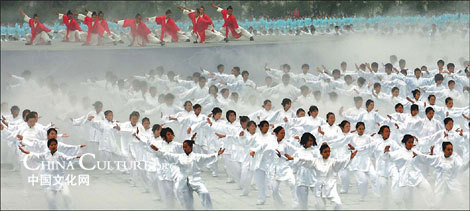
Niels Tsai, a kungfu enthusiast from Malaysia, was halfway up misty Wudang Mountain, Hubei province, at the end of last month when he was thrilled to see an elegant yet powerful Wudang-style tai chi performance delivered by 2,300 college students in a dirt square.
For centuries, the mountain in central China, in the middle reaches of the Yangtze River, has been a Mecca for Taoists.
It is also widely believed to be the cradle of tai chi, one of the three major neijia (internal) kungfu genres. The other two are xinyi quan and bagua zhang.

"This was the first time I had come to China seeking the roots of tai chi," said the businessman with excitement.
A long-time practitioner of tai chi, Tsai was delighted to see the original Wudang-style tai chi, the prototype for many kungfu styles that have found their way to many parts of the world.
"I am planning to be apprenticed by a local master to learn more about Wudang kungfu," he said.

Tsai was among tens of thousands of kungfu fans from home and abroad who last week flocked to Shiyan, the city at the foot of the Wudang Mountain.
They came for the Third World Traditional Wushu Championships, the highest-level and largest event for lovers of traditional Chinese martial art that is held every two years.
"Winning the championships is one of our aims. We hope to make friends and learn from other athletes who are practicing authentic Chinese kungfu like us," said Markovetc Igor, 40, a coach of one of the six kungfu teams from Russia that attended the event.










